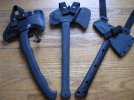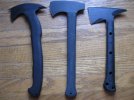Just to clarify, my point was not so much about adding weight, but about the weight's distribution. If you have a one pound axe that's handle heavy, it won't swing with nearly the same inertia and force as a one pound axe with more of a forward balance, where the bulk its mass is concentrated near the head in front of a lighter tapered, hollow tang.
The reason most manufacturers don't do this is that it adds a few steps to the process which makes it much more time consuming and increases wear on equipment. They also know that most of their customers buy their product based primarily on looks and price, with much less consideration given to actual performance. In the world of manufactured hawks and tactical axes, even $20 can make a big difference in how well the product sells. That's why the more discerning, performance oriented customers typically choose a custom axe from a skilled maker, leaving the factory made products to the more budget oriented or less discriminating clientele.
By the way if you draw out your design on graph paper you can estimate the total weight by counting up all the filled in "squares" to approximate your total area, multiplying it by the thickness of your stock to come up with your volume, and then multiplying the total volume by 0.283 (the weight in pounds of one cubic inch of steel). Remember to subtract about 40% of the volume from the beveled edge and another 25-30% of the volume of the tapered tang.
Also, if CAD isn't an option for you, then you can have your paper drawing converted into CAD format by your friendly local waterjet cutter. He'll charge you a fee to do that though. And quite honestly, the more I think about it, given your needs it probably makes more sense just to contact a custom maker to build one for you.



